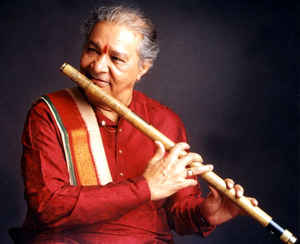


If fate had had some other plans, then Pandit Hariprasad Chaurasia would have become a wrestler like his father. Instead he became an artist widely acclaimed as the greatest exponent of Baansuri- the wooden flute. Over the years, if connoisseurs have gone ga- ga over the aalapi and zor of his flute during his classical performances, then common listeners have lapped up his melodious music in film albums like Silsila, Chaandani, Lamhe and Darr.
Although Pt. Hariprasad has been a traditionalist in his musical approach, he has never shied away from adapting to new trends of fusion music. His collaborations with international artists like John McLaughlin and Jan Garbarek have been received enthusiastically in world music. In Jan 2004 Dubai he came to perform alongside the famous Rock group Jethro Tull, headed by the redoubtable Ian Anderson- himself a renowned flautist, presenting an interesting fusion of two very different styles of music.
Taking this on-coming concert as an opportunity to interview the Indian maestro, I called him up at his Mumbai residence. Panditji found time amidst his busy schedule to answer my queries in a cool, courteous and unhurried manner.
Here are the excerpts from the interview:
On His Early Musical Influences:
My mother crooning lullabies in my ear is my earliest musical memory. Her sweet voice was the reason I got attracted towards music. Since my father wanted me to become a wrestler like him, I had to learn music on the sly. There is no doubt in my mind that my becoming a musician was God’s will.
I started off training to be a vocalist but found that my voice did not hold steady at higher octaves. That was the time my Guruji Pt. Rajaram suggested to switch to playing flute. He said, “So what if you can’t become a singer? You can make the flute sing instead.”
Pt. Bholanath started teaching me the art of flute- playing. Initially it was more of a generalized training. Later on as I was taken under tutelage of Annapurna Devi – the great daughter of legendary Ustad Allauddin Khan, I started learning the nuances of classical music in the tradition of Maihar gharana.
On Fusion Music:
I don’t agree with people saying that Indian and western music should not be fused. Yes, there are basic differences in these two schools of music. Indian music is about seriousness and devotion, whereas western music has a sense of fun and openness. Both have much to learn from each other. Like different kinds of clothes, people need different kinds of music.
I have collaborated with many international artists and I have always enjoyed these musical interactions. I enjoy meeting new people and learning about different musical styles and cultures.
On his ‘non- classical’ film music:
Where was the opportunity to use classical music in films like Chandani or Lamhe? They were romantic films and we (Shiv- Hari) made music to suit their mood. If we had had films like Anarkali, Mughal- E-Azam or Baiju- Bawra, we could have showed our classical prowess.
On changing face of audience:
I sincerely feel that over the years audiences have changed for the better. More and more youngsters are filling up the concert halls and they are not just looking for easy listening. Younger generation has certainly started appreciating the strengths and virtues of Indian classical music and that gives me a great hope for the future of the genre.